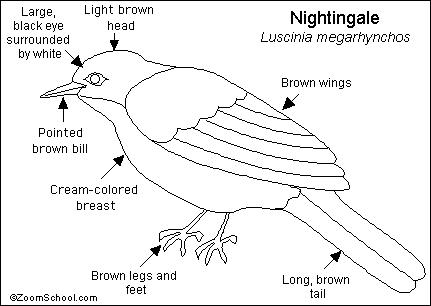
 |
| You might also like: | First-Year Bald Eagle | Nuthatch Printout | Javelina (Collared Peccary) Printout | Anteater Printout | Red-Tailed Hawk Printout | Today's featured page: Keel-Billed Toucan Read-and-Answer Quiz |
| All About Birds | EnchantedLearning.com Nightingale | Animal Printouts Label Me! Printouts |


Habitat and Range: Nightingales live in deciduous forests and thickets in much of Europe (excluding the far north) and central Asia. They spend the winters in north and central Africa.
Anatomy: The Nightingale is about 6 to 7 inches (15-18 cm) long and weighs about 1/2 to 1 ounce (14-28 g). Males and females are similar in appearance. The head, back, tail, and wings are brown; the belly and chest are cream-colored. The eyes are large and black.
Diet: The Nightingale eats insects, insect larvae, worms, spiders, berries, and fruit.
Eggs and Nests: The Nightingale's cup-like nest is built by the female and is hidden in a thicket close to the ground. It is made from twigs and leaves and is lined with grass. Females lay 4 to 5 pale olive-green to brown eggs in each clutch (a set of eggs laid at one time). The incubation period of the eggs is 11 to 12 days.
| Search the Enchanted Learning website for: |